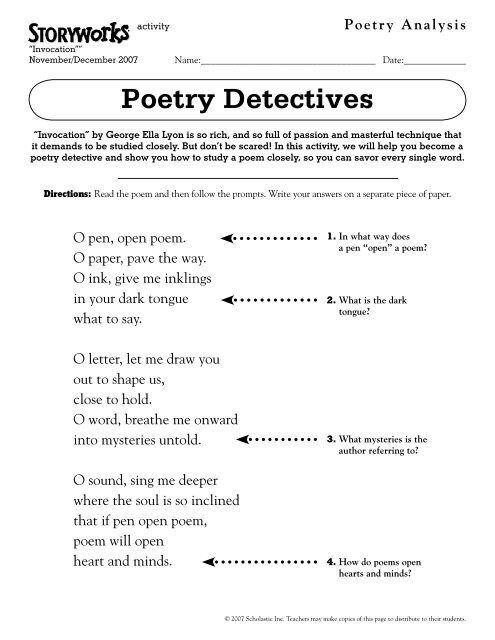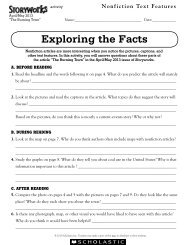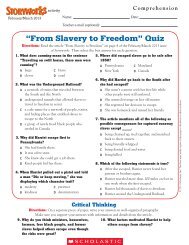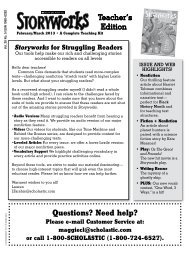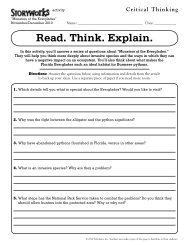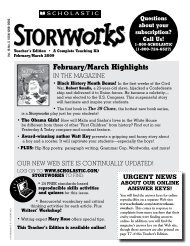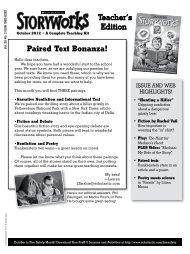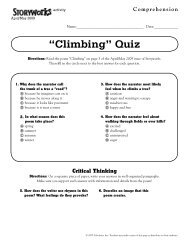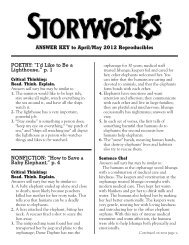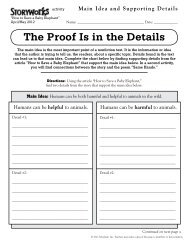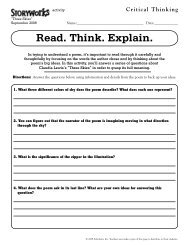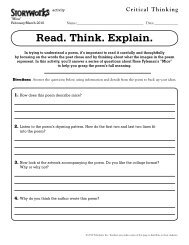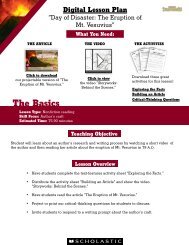Poetry Detectives - Scholastic
Poetry Detectives - Scholastic
Poetry Detectives - Scholastic
Create successful ePaper yourself
Turn your PDF publications into a flip-book with our unique Google optimized e-Paper software.
“Invocation””<br />
November/December 2007<br />
activity<br />
Name:____________________________________ Date:_____________<br />
<strong>Poetry</strong> <strong>Detectives</strong><br />
<strong>Poetry</strong> Analysis<br />
“Invocation” by George Ella Lyon is so rich, and so full of passion and masterful technique that<br />
it demands to be studied closely. But don’t be scared! In this activity, we will help you become a<br />
poetry detective and show you how to study a poem closely, so you can savor every single word.<br />
Directions: Read the poem and then follow the prompts. Write your answers on a separate piece of paper.<br />
O pen, open poem.<br />
O paper, pave the way.<br />
O ink, give me inklings<br />
in your dark tongue<br />
what to say.<br />
O letter, let me draw you<br />
out to shape us,<br />
close to hold.<br />
O word, breathe me onward<br />
into mysteries untold.<br />
O sound, sing me deeper<br />
where the soul is so inclined<br />
that if pen open poem,<br />
poem will open<br />
heart and minds.<br />
1. In what way does<br />
a pen “open” a poem?<br />
2. What is the dark<br />
tongue?<br />
3. What mysteries is the<br />
author referring to?<br />
4. How do poems open<br />
hearts and minds?<br />
© 2007 <strong>Scholastic</strong> Inc. Teachers may make copies of this page to distribute to their students.
“Invocation”<br />
November/December 2007<br />
1. Find three examples of personification in “Invocation.” Think about them, and write how you think<br />
the human actions make the objects seem different. We’ve done the first one for you.<br />
1. O paper, pave the way<br />
2. ____________________<br />
activity<br />
3. _____________________<br />
Personification<br />
Name:____________________________________ Date:_____________<br />
This Poem Is Alive!<br />
In the poem “Invocation,” George Ella Lyon asks for writing help from the tools of poetry—pen,<br />
paper, ink, and words—as if they were alive, like people. Writing about objects or animals as if<br />
they were human is called personification, and it can make a poem or story exciting and alive.<br />
In this activity, you will learn more about personification and how to use it in your own writing.<br />
Directions: Fill in the blanks below and then write your own poem.<br />
2. Now write three original sentences using personification.<br />
The paper can make space for the poem to begin. Like a<br />
construction worker paving a long street, the paper will<br />
remove all the clutter and lay a foundation.<br />
Write Now!<br />
Choose one of your original sentences and expand upon it to write your own poem on a separate sheet of paper.<br />
© 2007 <strong>Scholastic</strong> Inc. Teachers may make copies of this page to distribute to their students.
“The Spider Woman”<br />
November/December 2007<br />
activity<br />
Writers’ Workshop:<br />
Name:____________________________________ Date:_____________<br />
Secrets From Great Writers!<br />
ThIs monTh’s sEcrET: sImILEs and mETaphors<br />
similes and metaphors are both ways of describing something by comparing it to<br />
something else. The difference: a simile includes the words “like” or “as.” a metaphor does not.<br />
In his story “The spider Woman,” author Burkhard Bilger uses both similes and metaphors to<br />
make his descriptions come to life. In this activity, you will practice using them.<br />
Directions: Read each statement and answer the corresponding questions.<br />
1. Spiders are the X-men of the animal world.<br />
Is this a simile or a metaphor? How can you tell?<br />
What does it mean?<br />
Write a metaphor of your own that expresses the same idea.<br />
2. She moves with a spring in her step, like a cheerleader.<br />
Is this a simile or a metaphor? How can you tell?<br />
What does it mean?<br />
Write a simile of your own that expresses the same idea.<br />
Similes and Metaphors<br />
© 2007 <strong>Scholastic</strong> Inc. Teachers may make copies of this page to distribute to their students.
© 2007 <strong>Scholastic</strong> Inc. Teachers may make copies of this page to distribute to their students.<br />
“The Spider Woman”<br />
November/December 2007<br />
activity<br />
Fact/Opinion<br />
Name:____________________________________ Date:_____________<br />
A-MAZING Facts & Opinions<br />
“The spider Woman” is full of interesting facts, or true statements, about spiders. It also contains<br />
tons of opinions, or beliefs, as well (like spiders are scary!) In this activity, you will try to tell the<br />
difference between these two types of statements.<br />
Directions: Read each bubble below and decide which are facts and which are opinions. Then circle all the<br />
bubbles that contain facts. Draw a line through the maze, connecting<br />
She did not look<br />
like a spider<br />
hunter either.<br />
She had on tennis<br />
shoes, jeans, and a<br />
faded blue T-shirt.<br />
Greta Binford is<br />
41 years old.<br />
She specialized<br />
in arachnology. She moves with a<br />
spring in her step,<br />
like a cheerleader.<br />
They simply<br />
don’t see the<br />
point . . .<br />
Still, some<br />
spiders can<br />
kill.<br />
Some people aren’t<br />
even sensitive to<br />
the toxins.<br />
∞<br />
each bubble that contains a fact. You’ll know you’ve done the<br />
activity correctly when you reach the spider!<br />
Spiders are<br />
the X-men<br />
of the animal<br />
world.<br />
“It’s just<br />
too easy.”<br />
Spiders have a<br />
bad reputation,<br />
largely<br />
undeserved.<br />
The spiders<br />
seemed to be<br />
everywhere.<br />
Something was not<br />
quite right in the<br />
basement of Goodwill.<br />
Loxosceles laeta<br />
is a cousin of the<br />
brown recluse.<br />
. . . it’s<br />
helpful to<br />
remember . . .<br />
Bite victims sometimes look<br />
as if they have serious burns.<br />
Binford had<br />
30 live spiders<br />
in her vest.<br />
Their fangs<br />
are too<br />
small . . .<br />
. . . spiders<br />
have many fine<br />
qualities.<br />
. . . a harmless<br />
orb spider spins<br />
its glorious<br />
web. . .
“The Spider Woman”<br />
November/December 2007<br />
activity<br />
Knowledge Chart<br />
Name:____________________________________ Date:_____________<br />
KWL: Know, Want, Learn<br />
a great way to get the most out of a nonfiction article is to ask yourself a few questions before you<br />
start reading. What do you know about the subject already (or think you know)? What would you like<br />
to learn? after you’ve finished reading, it’s great to ask yourself, “What did I learn from this?”<br />
Directions: Before reading the article, write a list of facts you already know about spiders in the first<br />
column below. (Hint: Where do spiders live? What do they eat? Are all spiders dangerous?)<br />
In the next column, jot down all the information you want to learn about spiders.<br />
Then, read the article. After you finish, make a list of the facts you learned.<br />
KNOW WANT TO KNOW LEARNED<br />
© 2007 <strong>Scholastic</strong> Inc. Teachers may make copies of this page to distribute to their students.
activity<br />
Name:____________________________________ Date:_____________<br />
Reading & Thinking<br />
Exploring the facts and ideas in a nonfiction article will help you understand it better.<br />
Use this organizer with any of the nonfiction pieces you find in Storyworks.<br />
READiNg FOR iNFORmATiON<br />
TiTLE<br />
AuThOR<br />
This article is mainly about ___________________________________________________________.<br />
The main events of the article take place in ___________________ (name a location).<br />
The year or time period is __________________. Some important people mentioned in the article are<br />
__________________________________________________________________________________.<br />
Here are some facts I learned from this article (Write at least four):<br />
___________________________________________________________________________________<br />
___________________________________________________________________________________<br />
______________________________________________________________________________________<br />
_____________________________________________________________________________________.<br />
Put a star (*) by the facts you wrote above that are important in explaining what the article is about.<br />
Put an X by the facts that you find really interesting. (Some facts might have both a star and an X.)<br />
The facts with a star are important because<br />
1. _________________________________________________________________________________<br />
___________________________________________________________________________________<br />
2. _________________________________________________________________________________<br />
___________________________________________________________________________________<br />
The facts with an X are interesting because<br />
Reading Comprehension/Nonfiction Elements<br />
1. _________________________________________________________________________________<br />
___________________________________________________________________________________<br />
2. _________________________________________________________________________________<br />
___________________________________________________________________________________<br />
Continued<br />
© 2007 <strong>Scholastic</strong> Inc. Teachers may make copies of this page to distribute to their students.
mAiN iDEA<br />
activity<br />
Reading & Thinking page 2<br />
The main idea of this story is ___________________________________________________________<br />
__________________________________________________________________________________.<br />
Here are some details that support the main idea:<br />
1. _________________________________________________________________________________<br />
___________________________________________________________________________________<br />
2. _________________________________________________________________________________<br />
___________________________________________________________________________________<br />
3. _________________________________________________________________________________<br />
___________________________________________________________________________________<br />
Another idea presented in this story is ___________________________________________________<br />
__________________________________________________________________________________.<br />
Here are some details that support that idea:<br />
Reading Comprehension/Nonfiction Elements<br />
1. _________________________________________________________________________________<br />
___________________________________________________________________________________<br />
2. _________________________________________________________________________________<br />
___________________________________________________________________________________<br />
3. _________________________________________________________________________________<br />
___________________________________________________________________________________<br />
AuThOR’s PuRPOsE<br />
I think the author wrote this article because _______________________________________________<br />
___________________________________________________________________________________<br />
I think the author expresses the viewpoint, or opinion, that __________________________________<br />
___________________________________________________________________________________<br />
___________________________________________________________________________________<br />
I agree/disagree (circle one) with the author’s viewpoint because ______________________________<br />
___________________________________________________________________________________<br />
Continued<br />
© 2007 <strong>Scholastic</strong> Inc. Teachers may make copies of this page to distribute to their students.
CONNECTiONs<br />
activity<br />
Here’s how this article relates to (fill in at least one)<br />
Reading Comprehension/Nonfiction Elements<br />
Reading & Thinking page 3<br />
Something else I read:_________________________________________________________________<br />
__________________________________________________________________________________.<br />
Something else I know about:___________________________________________________________<br />
__________________________________________________________________________________.<br />
Something in my own life:_____________________________________________________________<br />
__________________________________________________________________________________.<br />
REsPONDiNg TO LiTERATuRE<br />
Would you recommend this article to a friend? Why or why not?<br />
___________________________________________________________________________________<br />
___________________________________________________________________________________<br />
___________________________________________________________________________________<br />
© 2007 <strong>Scholastic</strong> Inc. Teachers may make copies of this page to distribute to their students.
“Car Trouble”<br />
November/December 2007<br />
activity<br />
Compare/Contrast<br />
Name:____________________________________ Date:_____________<br />
Expectations vs. Reality<br />
In carolyn meyer’s story “car Trouble,” each character wants his or her vacation to be a certain<br />
way, but these hopes, or expectations, turn out to be different from what actually happens! In<br />
this activity, you will compare what the characters expect with what really happens.<br />
mum<br />
DAD<br />
JOE<br />
&<br />
ERiN<br />
Directions: Read “Car Trouble” and fill in the chart.<br />
What the characters expect What really happens<br />
Write Now!<br />
How do you think the characters in “Car Trouble” feel about the outcome of their trip? Do you think they<br />
preferred what actually happened over what they had expected? On a separate piece of paper, write a well-organized<br />
paragraph answering this question. Explain your answer by using your notes from above.<br />
© 2007 <strong>Scholastic</strong> Inc. Teachers may make copies of this page to distribute to their students.
“Car Trouble”<br />
November/December 2007<br />
activity<br />
1. Write a list of the events in “Car Trouble.” Use one sentence for each main action.<br />
Summarizing<br />
Name:____________________________________ Date:_____________<br />
Important Events<br />
how do you know if you’ve really understood a story? Try writing a summary of the events.<br />
The hardest part of summarizing a story is pinpointing the really important events—the<br />
moments that make up the central idea of the story. sometimes, the funniest bits, the best lines,<br />
or even your favorite character are not essential to understanding the story. In this activity, you<br />
will consider the events in “car Trouble” and figure out which ones belong in your summary.<br />
Directions: In the space below, write a list of the events in the short story “Car Trouble”<br />
Use a check or a star to identify the big events among the surrounding details.<br />
2. Look over your list and identify the most important actions. Cross off any event that is not needed to tell<br />
the story, even if it seems really interesting to you. Next, find the climax of the plot and the resolution.<br />
3. Using your notes from above, write a summary of “Car Trouble” on a separate piece of paper. Underline<br />
the climax and the resolution. Remember to make sure that each event you include is important.<br />
© 2007 <strong>Scholastic</strong> Inc. Teachers may make copies of this page to distribute to their students.
“Car Trouble”<br />
November/December 2007<br />
activity<br />
Text-to-Self<br />
Name:______________________________ Date:_____________<br />
My Route 66 Roadmap<br />
have you ever had a family vacation that went awry like Joe and Erin’s? do your parents’ ideas<br />
about what would be fun ever clash with your own? In this activity, you will think about how Erin<br />
and Joe’s experience connects to your own.<br />
1. in what way did Joe and Erin’s<br />
vacation not go according to plan?<br />
2. Describe an experience from your<br />
life that somehow connects to Joe<br />
and Erin’s.<br />
Directions: Answer each question in the blanks below.<br />
3. in what ways are Joe and Erin’s<br />
ideas about their vacation different<br />
from their parents’?<br />
4. Describe a time in which you and<br />
your parents had different ideas<br />
about how to spend a vacation.<br />
Continued ➤<br />
© 2007 <strong>Scholastic</strong> Inc. Teachers may make copies<br />
of this page to distribute to their students.
My Route 66 Roadmap, page 2<br />
5. What experiences did Joe and<br />
Erin have as they were welcomed<br />
by people from a culture different<br />
from their own?<br />
6. Describe an experience in which<br />
you learned about a new culture.<br />
7. What did Joe, Erin, and their<br />
parents learn on this vacation? how<br />
might these lessons affect their plans<br />
for a future vacation?<br />
8. Describe something new that you<br />
learned on a vacation or a class trip.<br />
Write Now!<br />
Using a separate piece of paper, choose your favorite example above and write a story about the time<br />
you had an experience similar to Joe and Erin’s. Use details like those in Carolyn Meyer’s story and<br />
specific examples from your own life.<br />
© 2007 <strong>Scholastic</strong> Inc. Teachers may make copies of this page to distribute to their students.
ChARACTER<br />
activity<br />
Reading Comprehension/Fiction Elements<br />
Name:____________________________________ Date:_____________<br />
Reading & Thinking<br />
Writing about the basic elements of a story can help you remember and understand it.<br />
Use this organizer with any of the fiction pieces in Storyworks to help you achieve<br />
a better understanding of it.<br />
TiTLE<br />
AuThOR<br />
The main character’s name is __________________________________________________________.<br />
Some words to describe the main character are (provide at least three) _________________________<br />
__________________________________________________________________________________.<br />
Some examples that show what the main character is like are_________________________________<br />
__________________________________________________________________________________<br />
__________________________________________________________________________________.<br />
Another character’s name is ___________________________________________________________.<br />
His/her relationship to the main character is ______________________________________________.<br />
Some words to describe this character are_________________________________________________<br />
__________________________________________________________________________________.<br />
Some examples that show what this character is like are_____________________________________<br />
__________________________________________________________________________________<br />
__________________________________________________________________________________.<br />
Another character’s name is ___________________________________________________________.<br />
His or her relationship to the main character is _________________________________________ __.<br />
Some words to describe this character are_________________________________________________<br />
__________________________________________________________________________________.<br />
Some examples that show what this character is like are_____________________________________<br />
___________________________________________________________________________________<br />
__________________________________________________________________________________.<br />
© 2007 <strong>Scholastic</strong> Inc. Teachers may make copies of this page to distribute to their students.
sETTiNg<br />
activity<br />
Reading & Thinking page 2<br />
The location of the setting is __________________________________________________________.<br />
The time period of the setting is ________________________________________________________.<br />
The atmosphere, or feeling that the setting creates, is (i.e., rich, poor, strange, comfortable, scary,<br />
friendly, etc.) _______________________________________________________________________.<br />
PLOT<br />
These are the main events that happen in the story at the<br />
Reading Comprehension/Fiction Elements<br />
Beginning: _________________________________________________________________________<br />
___________________________________________________________________________________<br />
Middle:____________________________________________________________________________<br />
___________________________________________________________________________________<br />
End:_______________________________________________________________________________<br />
___________________________________________________________________________________<br />
The main conflict of the story is ________________________________________________________<br />
__________________________________________________________________________________.<br />
The climax, or point at which the conflict comes to a peak, is_________________________________<br />
__________________________________________________________________________________.<br />
The conflict is resolved when___________________________________________________________<br />
__________________________________________________________________________________.<br />
© 2007 <strong>Scholastic</strong> Inc. Teachers may make copies of this page to distribute to their students.
LANguAgE<br />
activity<br />
The story is told by (a narrator, the main character, someone else) ____________________________.<br />
The story has a lot of dialogue/a little dialogue/no dialogue. (Circle one)<br />
The language in the story is (i.e., humorous, serious, simple, complicated)_______________________.<br />
LiTERARy DEviCEs (OPTiONAL):<br />
Give examples below of some literary devices from the story:<br />
Reading Comprehension/Fiction Elements<br />
Reading & Thinking page 3<br />
Metaphors _________________________________________________________________________<br />
___________________________________________________________________________________<br />
Similes ____________________________________________________________________________<br />
___________________________________________________________________________________<br />
ThEmE<br />
What are one or two big ideas you think the author wanted you to get from the story?<br />
___________________________________________________________________________________<br />
___________________________________________________________________________________<br />
___________________________________________________________________________________<br />
REsPONDiNg TO LiTERATuRE<br />
Would you recommend this story to a friend? Why or why not?<br />
___________________________________________________________________________________<br />
___________________________________________________________________________________<br />
___________________________________________________________________________________<br />
© 2007 <strong>Scholastic</strong> Inc. Teachers may make copies of this page to distribute to their students.
“Pictures of Hollis Woods”<br />
November/December 2007<br />
activity<br />
Understanding Character<br />
Name:______________________________ Date:_____________<br />
Making Connections<br />
how do you learn about characters? one way is to consider their relationships with the people<br />
around them. In this activity, you will consider how hollis Woods relates to the people around her,<br />
how they relate to her, and what these relationships tell you about hollis.<br />
Directions: In the sections below, describe Hollis’s relationship to each person listed.<br />
Tell how Hollis treats each person and how they treat her, and how in each case these<br />
relationships help Hollis change and grow during the play.<br />
EDNA JOsiE<br />
ThE REgANs<br />
hOLLis<br />
hERsELF<br />
Write Now!<br />
Now, on separate piece of paper, write about one of Hollis’s relationships and what it tells you about Hollis<br />
herself. In particular, tell how this relationship helped Hollis grow and change during the course of the play.<br />
© 2007 <strong>Scholastic</strong> Inc. Teachers may make copies of this page to distribute to their students.
“Pictures of Hollis Woods”<br />
November/December 2007<br />
activity<br />
Sequencing<br />
Name:____________________________________ Date:_____________<br />
Where on the Timeline?<br />
Pictures of Hollis Woods is an action-packed play, but you might find the story confusing<br />
because of all the flashbacks (moments when the plot flashes back to something that<br />
happened in the past). Figuring out the order in which big events in the play take place<br />
will help you gain a better understanding of what the story is actually about.<br />
Directions: Read the list of big events in the box to the left.<br />
Then, place a number in each oval on the timeline to the right in the order in which they happened.<br />
1. Hollis and Josie<br />
run away.<br />
2. Hollis meets the Regans.<br />
3. Josie and Hollis go to<br />
the ocean to paint.<br />
4. Hollis spends the<br />
summer with the Regans<br />
at their cabin.<br />
5. The Regans want<br />
to adopt Hollis.<br />
6. Hollis leaves<br />
the Regans.<br />
EvENTs sTART<br />
7. The Regans adopt<br />
Hollis.<br />
8. Steven crashes<br />
the truck.<br />
9. Hollis meets Josie.<br />
10. Edna decides to take<br />
Hollis away from Josie.<br />
“ ◊<br />
“<br />
END<br />
© 2007 <strong>Scholastic</strong> Inc. Teachers may make copies of this page to distribute to their students.
“Pictures of Hollis Woods””<br />
November/December 2007<br />
activity<br />
Making Inferences<br />
Name:____________________________________ Date:_____________<br />
Between the Lines<br />
To infer something is to draw a conclusion by looking at the facts. You might not have all the<br />
facts, but enough to make a judgment. The trick is to look very carefully at the information you<br />
do have and then try to draw a conclusion. In this activity, you will be making inferences<br />
from dialogue from Pictures of Hollis Woods.<br />
Directions: Read each line or series of lines of dialogue, and then answer the corresponding questions.<br />
Make sure to have the play Pictures of Hollis Woods handy so that you can refer to it for more information.<br />
1. HOllIS: I was always trouble for somebody (Prologue)<br />
What does this tell you about Hollis? What does she think of herself?<br />
How do her thoughts about herself change by the end of the play?<br />
2. JOSIE: I’d like to show you one of my favorite places. . . wait, isn’t it a school day?<br />
HOllIS: Uh . . . no. There’s no school today. (Scene 3)<br />
What is really going on here? How does it signal that there might be a problem with Josie?<br />
3. JOSIE: Oh, you have a wonderful eye. (Scene 3)<br />
HOllIS: You have a wonderful eye too.<br />
JOSIE: We have four wonderful eyes.<br />
What does this tell you about the relationship between Josie and Hollis.<br />
What does it tell you about Hollis’s feelings for Josie?<br />
Write Now!<br />
Choose one of the questions above and turn your answers<br />
into a well-organized paragraph, using details from the play to support your ideas.<br />
© 2007 <strong>Scholastic</strong> Inc. Teachers may make copies of this page to distribute to their students.
“Mad””<br />
November/December 2007<br />
Name:____________________________________ Date:_____________<br />
Seeing a Poem<br />
Each line in “mad” creates an image. Thinking about each image can help you figure out the<br />
poem’s meaning. In this activity, you will think about what the images in “mad” mean to you.<br />
What Naomi<br />
Wrote<br />
1. I got mad at my mother<br />
so I flew to the moon.<br />
activity<br />
2. My mother stood in the front<br />
yard like a pin dot searching<br />
for me.<br />
3. Then I whistled and she<br />
tipped her head.<br />
4. It gets cold at night<br />
on the moon.<br />
5. My mother sent up a silver<br />
thread for me to slide<br />
down on.<br />
Directions: Fill in the columns below. We did the first one for you.<br />
What<br />
i see<br />
A kid flying on a<br />
rocket to the moon<br />
Poetic Imagery<br />
What This<br />
means to me<br />
When people get mad, they<br />
want to escape. Also, maybe<br />
the rocket is propelled anger.<br />
© 2007 <strong>Scholastic</strong> Inc. Teachers may make copies of this page to distribute to their students.
“Mad””<br />
November/December 2007<br />
activity<br />
<strong>Poetry</strong> Writing<br />
Name:____________________________________ Date:_____________<br />
What Happens When You Get Mad?<br />
In her wonderful poem “mad,” naomi shihab nye equates the experience of being mad at her<br />
mother with flying to the moon, and then returning to her mother’s open arms. how do you feel<br />
when you get mad at a family member or friend? What image comes to mind that best describes<br />
this feeling? In this activity, we will help you write your own poem about that very subject.<br />
Directions: Read “Mad” again. Then fill in the blanks below with your own ideas,<br />
using Naomi Shihab Nye’s poem as your guide. Copy your finished poem onto a separate piece of paper.<br />
mAD by __________<br />
Your name here<br />
I got mad at my ______________<br />
so I ______________.<br />
What do you do when you’re mad at this person? Where do you go?<br />
I could still see ______________<br />
Describe what you see.<br />
______________.<br />
My ______________<br />
What does this person do when you’re mad at him or her?<br />
like a ______________<br />
searching for me.<br />
He/She ______________<br />
He/She ______________.<br />
Then I ______________ and he/she ______________.<br />
Describe what you do to get his or her attention.<br />
Name a person you’ve recently been mad at.<br />
Provide a supporting detail.<br />
Pick a simile that best describes this image.<br />
Describe what this person does next.<br />
In different words, restate what he or she does.<br />
It feels ______________<br />
My ______________<br />
What does this person do to make you feel better?<br />
for me to ______________.<br />
He/She knows me so well.<br />
Tell what he or she does in response.<br />
Describe how it feels in the place that you go when you’re mad at this person.<br />
How does this help you return to him or her?<br />
He/She knows I like ______________.<br />
Name something you like.<br />
© 2007 <strong>Scholastic</strong> Inc. Teachers may make copies of this page to distribute to their students.


